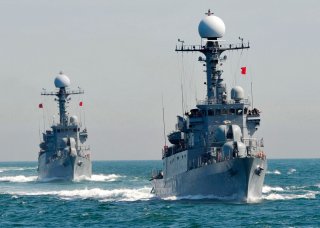How South Korea Made Itself Into a Submarine Powerhouse
Worth every won.
Key Point: Seoul has built a good number of very well-made submarines. Here's how they help deter North Korea.
While South Korea is not known for its submarine fleet, it possesses a decent sized, quietly capable fleet. The ultimate goal of the Republic of Korea Navy (ROKN) is to produce their own diesel-electric attack submarine. The current fleet is relatively modern and possesses a strong overall capability for a diesel-electric fleet. But how does it stack up against the sub fleet of China and North Korea? Like many South Korean projects (eg. KDX-I, KDX-II, KDX-III for destroyers), the sub fleet is produced in a series of three. The KSS-I and KSS-II are German designs. The KSS-III will be the indigenous diesel-electric attack submarine. Some rumors have been floating around about a KSS-N nuclear submarine, but there is no concrete information on whether this proposal is being taken seriously. All submarines are relatively recent purchases, with the KSS-I being delivered in a series of two deals from 1993 to 2001, and the KSS-II being delivered from 2007 to the current day.
This article first appeared in June 2018. It is being republished due to reader interest.
Consider the KSS-I, alternately referred to as the Chang Bogo-class, or Type 209/1200 in the German export designation is a simple diesel-electric attack submarine. The number “1200” in the German designation indicates the tonnage of the submarine. Armed with eight standard 533mm torpedo tubes, the primary weapon of the KSS-I is the German SUT torpedo, it is an export torpedo originally developed in the 1970s. The torpedo is electrically driven and wire-guided, with a max speed of 35 knots and a range of around 40km.
The ROKN operates the Mod 2 variant of the SUT, which allows the firing submarine to receive data from the seeker of the torpedo, potentially increasing accuracy and allowing it to act as a remote sensor for the submarine. The ROKN ordered two batches of 48 SUT Mod 2s along with their Type 209 submarines. The KSS-I was later modernized to utilize sub-launched Harpoon missiles as well as the indigenous Korean “White Shark” active-homing fire-and-forget torpedo. Nine KSS-1s are operated by the ROKN, with no plans to acquire more. Further modernization of the type is being considered, including attaching additional sonar arrays and possibly converting them from diesel-electric to air-independent propulsion. The design continues to be produced for export, Korean companies acquired a license to build the submarine and are selling three of the type to Indonesia.
The KSS-II, or Son-Won-Il-class in ROKN service, or Type 214 continues the trend of the ROKN fielding German submarine designs. Unlike the KSS-I, the first ship of which was built in Germany, all KSS-IIs are built by Korean companies: Daewoo and Hyundai. The major advantage of the KSS-II is that it utilizes air-independent propulsion (AIP), allowing it to be more stealthy and stay underwater longer than earlier designs. It accomplishes this through the use of Siemens polymer electrolyte membrane fuel cells. The AIP system augments the existing diesel-electric powerplant, only running when the submarine is submerged. As installed on the KSS-II, the AIP system gives an underwater endurance of two weeks. Armament is generally similar to the KSS-I, with the submarine being able to use torpedoes and anti-ship submarine-launch missiles. The type also fields the ISUS 90 command and control system that amalgamates all sensor input and command and control functions. As standard per its class, the KSS-II is fitted with bow and flank sonar modules. The final KSS-II was completed in September 2017, being the ninth boat of its class.
After the completion of the KSS-II, South Korea wanted to craft its own design. The KSS-III is looking to be heavier and larger than the KSS-II and KSS-I.
It’s estimated that the KSS-III will weigh around 3000 tons, more than twice as heavy as the KSS-I. A lot of the weight probably comes from the expanded armament of the KSS-III: it’s designed with a vertical launch system that can fire the Korean Hyunmoon ballistic missile or a myriad of other missiles, possibly including the American Tomahawk. This would give the ROKN a significant sub strike capability, posing a threat against China or other larger navies they may be facing. Nine KSS-IIIs are planned to be procured in three batches of three, with increasing levels of indigenous technology in each batch. Notably, the number of VLS cells is expected to increase from six to ten in later batches of the KSS-III. No KSS-IIIs are complete, however, the keel for the first KSS-III was laid in 2016. Other KSS-IIIs are being produced at the same time, with steel being cut for the third KSS-III in July 2017.
The KSS-II and KSS-III designs compare favorably to any submarine the Korean People’s Navy can field. They possess advanced AIP propulsion designs allowing them to run quieter and longer and can fire more modern torpedos. They also have a superior sensor fit, having flank sonars, which have not been reported as being equipped on any North Korean submarines. Against Chinese submarines, the technology edge is not as significant. In general, the armament fit of the KSS-series appears to be superior, with the SUT Mod 2 having a longer range and targeting flexibility compared to the Yu-4 and Yu-6 which arm China’s Type 039 attack submarines. However, the latest Chinese submarines, the Type 039A class, appear to incorporate advanced sonar signature reduction techniques which may impede the ability for the Korean submarines to detect them.
Charlie Gao studied Political and Computer Science at Grinnell College and is a frequent commentator on defense and national security issues.
This article first appeared in June 2018. It is being republished due to reader interest.
Image: Reuters

